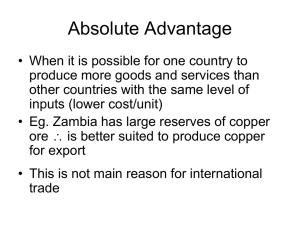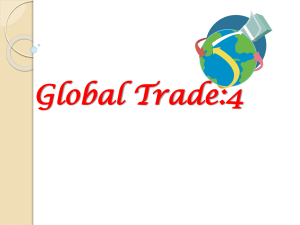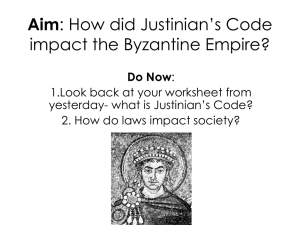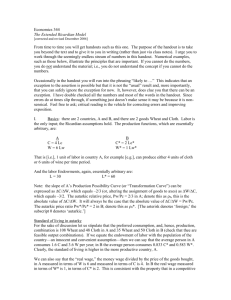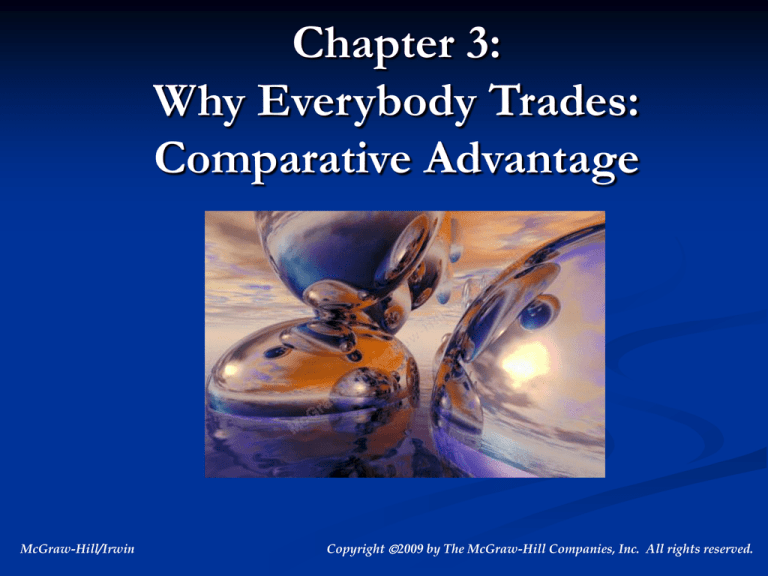
Chapter 3:
Why Everybody Trades:
Comparative Advantage
McGraw-Hill/Irwin
Copyright 2009 by The McGraw-Hill Companies, Inc. All rights reserved.
Contents
Mercantilism
Absolute Advantage
Comparative Advantage
Production Possibility Curve
3-2
Adam Smith’s theory of the absolute
advantage
Assumptions:
Two countries – the US and the rest of the
world
Two products – wheat and cloth
Each product uses one resource – labour
Two ways to show each country’s ability to
produce
Quantity of output per labour hour
Labour hours needed to produce a unit of
output
3-3
Adam Smith’s Example
Absolute Advantage
3-4
The US has higher productivity on wheat and
hence an absolute advantage in wheat
What about the rest of the world?
What are the changes in world production if
1 hr of labour is shifted from cloth to wheat
in the US? From wheat to cloth in the rest of
the world?
US: -0.25 cloth; +0.5 wheat
ROW: +1 cloth; -0.4 wheat
World: +.75 cloth; +0.1 wheat
Global production efficiency is increased due
to trade
3-5
Ricardo’s Example:
Comparative Advantage
3-6
Ricardo’s theory of comparative
advantage
What if a country has absolute advantage in
both products? Will this country benefit from
trade?
The principle of the comparative advantage
A country will EXPORT the goods that it can
produce at a LOWER OPPORTUNITY COST
and
IMPORT the goods that it would otherwise
produce at a HIGHER OPPORTUNITY COST
3-7
Ricardo focused on labor productivity (or
resource productivity more generally) for
different products in different countries
Basis for trade: Relative differences in labor
(resource) productivity.
3-8
Which country has an absolute advantage in
wheat?
In cloth?
The opportunity cost (price) of cloth in the US is
the amount of wheat that we have to give up in
order to produce a unit of cloth
The opportunity cost of cloth is 2 W/C
[0.5/0.25] or [4/2]
3-9
The opportunity cost (price) of 1 unit of cloth in
ROW is the amount of wheat that they have to
give up,
The opportunity cost of cloth in ROW is
0.67W/C [0.67/1]or [1/1.5]
What about the prices of wheat?
Wheat in US 0.5 C/W [.25/.5] or [2/4]
Wheat in ROW 1.5 C/W [1/.67] or [1.5/1]
Which product is cheaper in the US? In ROW?
3-10
Ricardo’s Example:
No-Trade Relative Prices
3-11
Arbitrage (trade) is possible – buy cloth in ROW
for 0.67W/C and sell in the US for 2W/C
Eventually, the world price for cloth will be
established between 0.67 and 2W/C. Suppose it
is 1W/C
And the world price of wheat between 0.5 and
1.5 C/W
3-12
Gains from trade:
US
give up ½ unit of cloth to produce 1 unit of wheat for export
(domestic substitution and specialization)
import 1 unit of cloth in exchange for exporting 1 unit of
wheat
US is better-off by ½ unit of cloth after trade
ROW
give up 2/3 unit of wheat to produce a unit of cloth for
export
import 1 unit of wheat in exchange for exporting 1 unit of
cloth
ROW is better-off by 1/3 unit of wheat after trade
3-13
Figure 3.1 – The Gains from Trade,
Shown for Ricardo’s Constant-Cost Case
3-14
The PPC with constant costs
If the US has 100 billion labour hours and it
produces only wheat, how much wheat will it
produce?
50 billion units of wheat
How much cloth will the US produce with 100
billion labour hours (if only producing cloth)?
25 billion units of cloth
3-15
The PPC with constant costs
If the ROW has 100 billion labour hours and it
only produces cloth, how much cloth will it
produce?
100 billion units of cloth
How much wheat (assuming only wheat is
produced)?
67 billion units of wheat
3-16
The PPC with constant costs
The US PPC has a constant slope of
50/25=2W/C
The ROW PPC has a constant slope of
67/100=0.67W/C
Suppose that without trade each country
produces in p.So on its PPC
The trade line has a slope of 1W/C
Thus each country can consume at point C on
its trade line
3-17
US
Now produces 30 units of wheat and exports 10
After producing 30 units of wheat (60 labour hours), the
US can produce 10 units of cloth domestically (40 labour
hours)
Import 10 units of cloth from ROW at a price of 1
3-18
The PPC with constant costs
US
Now produces 30 units of wheat
After producing 30 units of wheat (60 labour hours),
the US can produce 10 units of cloth domestically
(40 labour hours)
ROW
ROW now produces 80 units of cloth using 80
labour hours
The remaining 20 labour hours are used to produce
wheat
3-19
3-20
Ricardo’s Theory of Trade
Comparative advantage
A country will export products that it can produce at
a low opportunity cost (in terms of other goods that
could be produced within the country).
A country will import products that it would
otherwise produce at a high opportunity cost.
Ricardo focused on labor productivity (or resource
productivity more generally) for different products in
different countries.
Basis for trade: Relative differences in labor
(resource) productivity.
3-21
3-22
3-23
3-24
3-25
3-26
3-27
Summary
Mercantilism
Absolute Advantage
Comparative Advantage
The Ricardian Model
3-28







